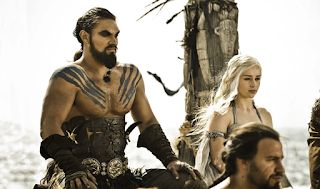A
Mixed Bag of Mixed Races
To
my mind, there is no better example of the unconscious and, likely, unintentional
racism of the fantasy genre than the various iterations of the concept of “mixed
races.” The idea of races in fantasy is problematic enough on its own and
steeped in the cultural mindset of the early 1900s, but an argument could be
made that this conceptualization of fantasy races has become more nuanced over
time, allowing for good and evil to exist within each of them. This same
argument for nuance however cannot be made for the mixed fantasy races.
Starting
where virtually all fantasy tropes originate, the idea of mixed races in
fantasy first reared its head in the works of J.R.R. Tolkien. Considering
Tolkien’s love for elves, it is no surprise that there should be kids born from
the union of elves and humans, though to my memory there are no specifically
named half-elven children in his works, only couplings of elves and humans. Yet
it is only these races that are known to ever marry or give birth to children
with each other. No elf or human ever has romantic relations with any dwarf,
hobbit, or orc, and it is certainly telling that so many fans of Tolkien
complained about the addition of a romance between Tauriel and Kili in Peter
Jackson’s film adaptations of The Hobbit. However, in this latter case, I would
argue it was due to poor writing as many fans online seem to enjoy shipping
Legolas and Gimli together.
Regardless,
the legacy of the half-elves being the only mixed race in fantasy has been
carried on to the modern day by works such as Michael Sullivan’s Riyria
Chronicles. To my knowledge, the only place one might find a half-dwarf is in
C. S. Lewis’s Prince Caspian.
One
strange mixed races that, at first, seems to contradict the trend of mixing
humans with the “prettier” race are half-orcs. Appearing most notably in the
Dungeons and Dragons tabletop roleplaying game, half-orcs are actually perhaps
one of the most problematic examples of a fantasy mixed race as it relies on
the stereotype of the savage and brutal orcs as a part of their biology that
the character must often struggle to overcome, usually through the influence of
their human blood.
Though
perhaps you have noticed something while reading this, every time “half” is
added before another race, it always means half human, half something else.
While it is understandable that we, as human, would be human-centric in our
fantasy and naming conventions, the cultural basis of most fantasy races is
fairly revealing of the eurocentrism of Western fantasy as well. Why then are
there no names for half-dwarf half-elven peoples?
This
is especially odd considering that humans are notoriously experimental in their
mating in the real world. And these races of fantasy worlds have supposedly
lived with each other for several centuries at least. It is ridiculous to think
that there wouldn’t be every combination under the sun and the moon. Perhaps
this reveals how we like to clean up history and pretend that real mixed races
and racial mingling didn’t exist until recently, which is of course not true.
As with most people in our world today, “pure” race people should be a massive
minority in every fantasy world.
--Brian Lazarow



This blog brings up many interesting points that spark many different conversation topics. A specific example would be the idea of the "not pure" race being unimportant enough to be named. This makes me think of Helen Young's idea of Habits of Whiteness where the idea of the White body is placed into works such as The Silmarillion. I, too, find it ludicrous that "White ideals" such as being an elite, pure race is even a thought when the White race is a mix of many. The idea that an impure being such as a half-elf not having a name is interesting to me, because it reminds me of these false ideas many have about what is "pure" and what is not.
ReplyDelete
ReplyDeleteFirstly, pretty decent blog. The extensiveness of the idea of mixing races with both tolkien fiction and tabletop games brings up the intentions behind the creators. Within a recent reading by Helen Young, “Founding Fantasy: J.R.R. Tolkien and Robert E. Howard”, She states that “mixing races is problematic in tolkien’s world”. Tolkien was influenced by much of European culture and only had elves (presumed as "white") and human combinations known as the half-elven children as said by your essay. Even then, in other things that contain mixing of ogres, dwarves, or orcs, those breeds don't contain names nor are very favored since their persona is featured as bad.
Much has been written about what the orcs could represent, but they have been described by Tolkien alternatively as inspired by Mongols and as black-skinned, so even monstrous races are not wholly separate sadly from real world influences. See section 1.1 e.g. in http://tolkiengateway.net/wiki/Racism_in_Tolkien's_Works.
ReplyDelete